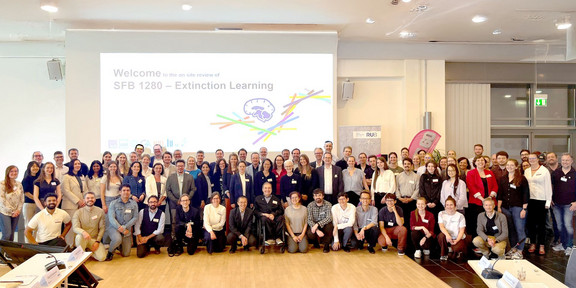Extension for Collaborative Research Center Extinction Learning
- UA Ruhr
- Research

How does the brain manage to learn to forget? Can we "unlearn" anxiety - and what does this mean for the treatment of anxiety or pain disorders? The Collaborative Research Center 1280 "Extinction Learning" has been investigating these questions since 2017. The network, coordinated by Ruhr University Bochum, was approved by the German Research Foundation for a third funding period without any cuts. The University Hospital of the University of Duisburg-Essen is home to the co-spokesperson, Prof. Dr. Dagmar Timmann, and five sub-projects of the collaborative research center. "This means that this ground-breaking, internationally acclaimed work can be continued," said a delighted Prof. Dr. Martin Paul, Rector of Ruhr University Bochum. "I would like to congratulate my colleagues on this success."
Learning and relearning
The process of initial learning is well understood - but extinction learning is much more complex. Extinction learning is not a simple erasure, but a new learning process: a fresh memory trace is superimposed on an old one without completely erasing it. Under certain circumstances, the supposedly forgotten can return - for example as part of a fear response.
"In the past funding period, we were able to identify the neuronal network of extinction learning and clarify the reasons for the context dependency in the memory of past events," explains the spokesperson of the CRC, Prof. Dr. Onur Güntürkün from Ruhr University Bochum. "In addition, disease-, stimulus-, stress- and cognition-related factors were discovered that influence therapy outcomes."
In the coming years, the team wants to delve even deeper into the mechanisms of forgetting. "We want to understand how the neuronal extinction network changes during learning and remembering and why contextual stimuli play such a strong role," summarizes co-spokesperson Prof. Dr. Dagmar Timmann from the University of Duisburg-Essen. "Our aim is to translate this basic research into clinical practice - so that therapy processes become more targeted and effective."
Extended collaboration
The successes of the first two funding periods are based on the close collaboration between experts from psychology, neurology, biology and theoretical neuroscience. New research locations have also been acquired for the coming funding period: The University of Luxembourg, the Hamburg Medical School and the Georg-August University of Göttingen are joining the proven team.
Further funding for Ruhr University Bochum
RuhryUniversity Bochum is not only pleased about the extension of the CRC "Extinction Learning", but also about the continuation of CRC 1316 "Transient Atmospheric Pressure Plasmas - from Plasma to Liquids to Solids". The spokesperson is Prof. Achim von Keudell. The CRC brings together expertise from various fields of research, including plasma physics, surface physics, chemistry, biotechnology and engineering. In addition to researchers from Bochum, a group from the Department of Electrochemistry at the University of Ulm and the Fritz Haber Institute in Berlin are also involved in the CRC. In the first two funding periods, the researchers have gained insights into the excitation of plasma species and their interaction with surfaces and identified various synergies between plasma catalysis, plasma electrolysis and plasma-assisted biocatalysis. For further research, the team wants to consolidate the basic understanding of all processes and their modeling and simulation as well as develop prototypes for larger plants for selective plasma-based material conversion.
More information can be found on the SFB homepage.

